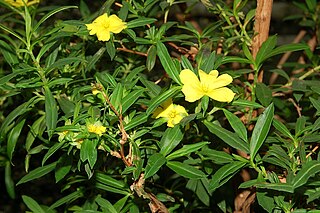
Hibbertia hypericoides, commonly known as yellow buttercups, is a small shrub species that is endemic to the south-west of Western Australia. It grows to between 0.2 and 1 metre high and has yellow flowers which appear between April and December in the species' native range.

Hibbertia cuneiformis, commonly known as cut-leaf hibbertia, is a shrub species that is endemic to the south-west of Western Australia. It grows to between 1 and 2 metres tall and has yellow flowers which appear from January to March and June to November in the species' native range.

Hibbertia serrata, commonly known as serrate-leaved guinea-flower, is a shrub that is endemic to the south-west of Western Australia. It grows to between 0.1 and 2 metres high and has yellow flowers which appear between August and December in the species' native range.

Acacia chartacea is a shrub or tree belonging to the genus Acacia and the subgenus Phyllodineae endemic to an area along the west coast of Western Australia.
Hibbertia abyssus, commonly known as Bandalup buttercup, is a species of flowering plant in the family Dilleniaceae and is endemic to a restricted area of Western Australia. It is an erect shrub with linear to tapering leaves and yellow flowers arranged singly in leaf axils with the five stamens all on one side of the carpels.
Hibbertia acrotrichion is a species of flowering plant in the family Dilleniaceae and is endemic to a restricted area of Western Australia. It is a small, erect shrub with linear, cylindrical leaves and yellow flowers arranged singly in leaf axils with eleven stamens arranged in groups.

Hibbertia amplexicaulis is a shrub in the Dilleniaceae family that is native to Western Australia.
Hibbertia ancistrophylla is a shrub in the Dilleniaceae family that is native to Western Australia.
Hibbertia ancistrotricha is a shrub in the Dilleniaceae family that is native to Western Australia.
Hibbertia andrewsiana is a shrub in the Dilleniaceae family that is native to Western Australia.

Hibbertia aurea is a shrub in the Dilleniaceae family that is native to Western Australia.
Hibbertia axillibarba is a shrub in the Dilleniaceae family that is native to Western Australia.
Hibbertia carinata is a shrub in the Dilleniaceae family that is native to Western Australia.
Hibbertia charlesii is a shrub in the Dilleniaceae family that is native to Western Australia.
Hibbertia ferruginea is a shrub in the Dilleniaceae family that is native to Western Australia.

Hibbertia commutata is a shrub in the Dilleniaceae family that is native to Western Australia.
Hibbertia crassifolia is a shrub in the Dilleniaceae family that is native to Western Australia.
Hibbertia cunninghamii is a shrub in the Dilleniaceae family that is native to Western Australia.
Hibbertia depressa is a shrub in the Dilleniaceae family that is native to Western Australia.

Hibbertia acicularis, commonly known as prickly guinea-flower, is a species of flowering plant in the family Dilleniaceae and is endemic to eastern Australia. It is an erect or prostrate shrub with linear to lance-shaped leaves and yellow flowers arranged singly in leaf axils with the six to eight stamens joined at the base, in a single cluster.








